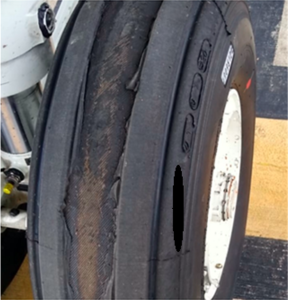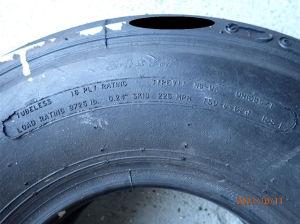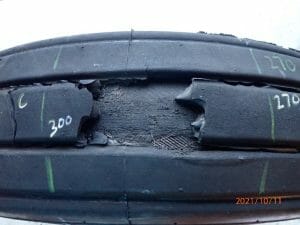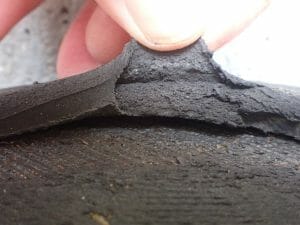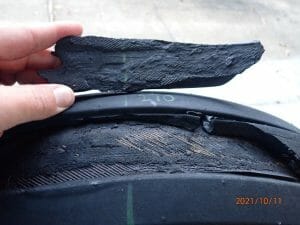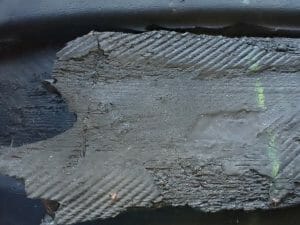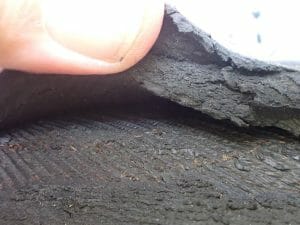Aircraft Tire Failure Analysis Case
U.S. Forensic was retained to conduct an analysis on an aircraft tire that failed during takeoff. The airline requested that an investigation be conducted to determine the cause of the tire failure.
Case Background
In early July of 2021, a left front nose tire failure occurred on an Embraer 190/195 aircraft as it was taking off down the runway. According to a representative from the airline, the subject tire was mounted to the wheel three days prior to its installation on the aircraft by company personnel. At the same time of its assembly, the tire and wheel were inflated with nitrogen to 141 pounds per square inch, which fit the parameters of the tire manufacturers  recommended pressure and was in line with the aircraft maintenance manuals specified pressure rating of the front nose tire while the aircraft is grounded. 24 hours after assembly, the pressure was again checked and the tire and wheel assembly was cleared for use. Upon installation on the day of the incident, tire pressures were checked and recorded at 141 pounds per square inch. The ambient temperature was 77 degrees Fahrenheit. The subject tire had completed five cycles on the aircraft and was beginning a sixth cycle during takeoff when the tire failure occurred.
recommended pressure and was in line with the aircraft maintenance manuals specified pressure rating of the front nose tire while the aircraft is grounded. 24 hours after assembly, the pressure was again checked and the tire and wheel assembly was cleared for use. Upon installation on the day of the incident, tire pressures were checked and recorded at 141 pounds per square inch. The ambient temperature was 77 degrees Fahrenheit. The subject tire had completed five cycles on the aircraft and was beginning a sixth cycle during takeoff when the tire failure occurred.
Observations
A photograph was provided from the day of the incident after the failure occurred showing that the tire and wheel assembly were still mounted to the aircraft. The tire had a center section of the tread missing and was still inflated. Upon examining the tire, the manufacturer name and serial number were obtained, along with the date and location of its production. It was also determined that the tire had been retreaded once. The company name, location and date of the retread was also indicated by markings on the tire.
- View of the left nose subject tire and wheel assembly after the tread separation occurred. The tire was still installed on the aircraft and inflated.
- Closer view of the sidewall pocket plate, size and retread pocket plates.
It was determined that the subject tire was approximately 2.5 years old at the time of the failure and the retread was approximately 1.5 years old. It was also noted that the tread separation occurred near the tread splice of the retread. By design, the tire had five circumferential ribs and 4 circumferential tread grooves. The tread vents were only worn off in the center rib. No apparent damage was present to either sidewall of the tire. Also observed on the tread edge adjacent to the exposed carcass was an irregular bulging shape in the tread. The edge of the tread was able to be lifted relative to the carcass of the tire.
Tire Failure Analysis
The tire was the correct size with the correct load rating and within the proper inflation specification for the Embraer 190/195 aircraft per the tire manufacturer part reference guide. The tread separation occurred near the tread splice of the retread and was mostly between the tread rubber and the bias ply carcass and partially between the tread rubber and the ground carcass retread surface.
- View of tread fragment C matched up to the tire along with the missing fragment and the bulged area adjacent to fragment B.
- Close view of the bulge with porosity and improperly mixed rubber.
A lack of adhesion was observed in areas adjacent to the separated tread between the carcass and the tread rubber. The subject tire rubber had an area with irregular texture that was consistent with improperly mixed rubber. This was a manufacturing defect in the retread applied to the tire. The improperly mixed rubber area was present adjacent to the area of the tread separation and the missing tread fragment.
- Closer view of the underside of tread fragment B adjacent to the area it separated from the tire.
- Closer view of the underside of tread fragment B with perpendicular line which was likely the tread splice.
- Closer view of the low or no adhesion between the tread and the carcass of the tire.
Results & Conclusions
- Based on the tire identification number, the subject tire was produced in the manufacturer’s plant the ninety-fifth day of 2019. The subject tire was approximately 2.4 years old at the time of the failure. The tire had been retreaded once on January 7, 2020. The retread was approximately 1.5 years old at the time of the failure. The tire was put into service on the day of the failure and had 5 cycles present.
- The Embraer 190/195 aircraft maintenance manual (AMM) specified the normal cold operating inflation pressure of the front nose tire while the aircraft was on the ground be 131 -0/+10 psi (i.e. 131 to 141 psi). Records received from the airline indicate the subject tire pressure was checked with a calibrated gauge and within this normal cold operation pressure range when it was checked 5 cycles before on the day of the incident.
- While the actual load on the subject tire was not known, aircraft loading during the 5 cycles would be needed to confirm that the tire was not overloaded.
- The tire was the correct size with the correct load rating fitment and within the proper inflation specification for the subject Embraer 190/195 aircraft per the tire company’s part reference guide.
- The subject tire experienced a tread separation that was mostly between the tread rubber and the bias ply carcass and partially between the tread rubber and the ground carcass retread surface.
- The tread separation occurred near the tread splice of the retread (near 280 degrees), over the inner liner splice (near 220 degrees) and adjacent to the edge of the patch weight installed near 200 degrees on the inner liner. Pressurization testing would need to be completed to determine if the inner liner splice, the patch weight installation and/or the awl vent holes in the lower sidewalls were functioning properly.
- The subject tire had an area of improperly mixed rubber with the tread. This was a manufacturing defect in the retread applied to the subject tire.
